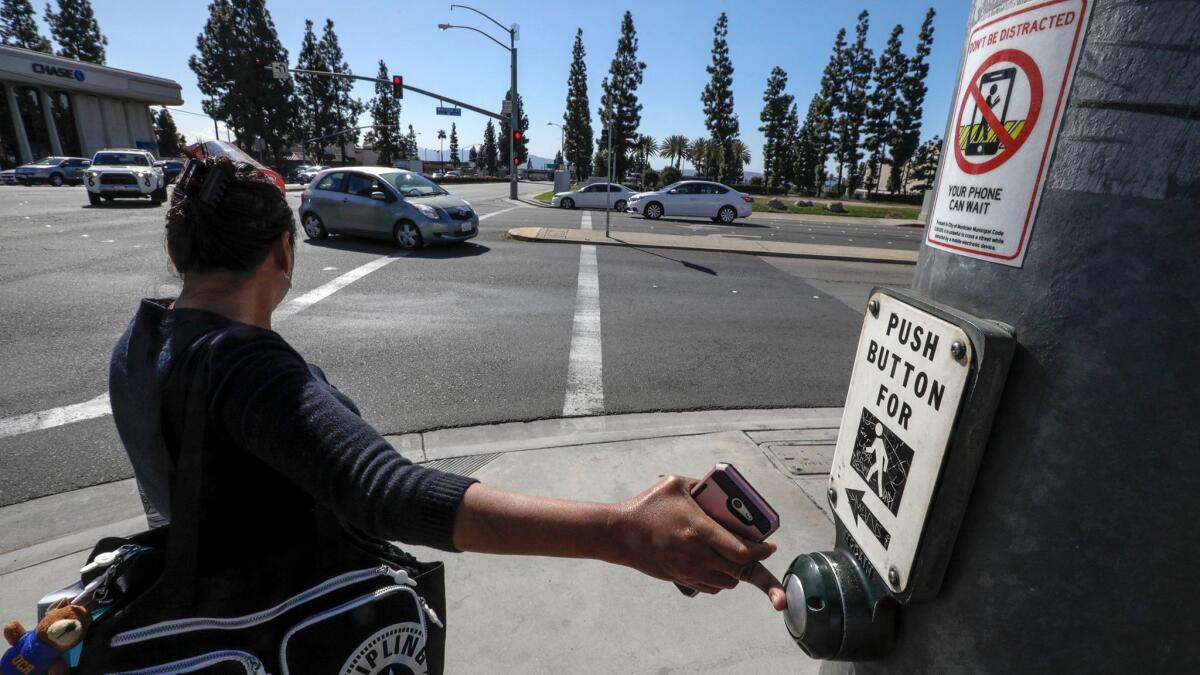In this Pomona Valley city, it’s now illegal to cross the street while on the phone

Chances are, you’ve had this experience: You’re behind the wheel at a stop sign or traffic light and have the right of way, when a pedestrian, looking down at a cellphone, steps off the curb in front of your car.
Now, one Southern California city is trying to tackle so-called distracted walking, making it a ticket-worthy offense to cross the street while on the phone. In Montclair, a 5.5-square-mile town just east of Pomona, pedestrians can’t text, talk on the phone, or listen to music or podcasts with two earbuds in while in a crosswalk. 911 calls are an exception.
For the record:
3:50 p.m. Feb. 25, 2018A previous version of this article incorrectly suggested that the only group of road users that have experienced a rise in fatalities in recent years were pedestrians.
“The youth admit that they are distracted by their cellphones,” City Manager Edward Starr said. “This has turned out to be a reminder for them that their lives are on the line.”
Starr said he was pondering a way last fall to address distracted walking in the city, so he turned to Google. He came across some creative — and probably not entirely serious — ways cities around the globe have tackled the problem.
At an amusement park in Chongqing, China, called Foreigners’ Street, Starr said, there’s a 100-foot phone lane to prevent people from bumping into each other. A similar installment exists in Antwerp, Belgium. As it turned out, the mobile lane experiment was first executed in Washington, D.C.
“I thought, ‘Well, we can’t do that,’ ” Starr said. “Because the issue is really about them being distracted as they’re crossing the street.”
Eventually, he discovered a distracted walking ordinance implemented last year in Honolulu. Taking cues from Hawaii’s capital, Starr’s staff drafted a law that was approved by the City Council in December.
For now, first-time offenders will get a warning. Authorities will start giving out tickets in August. The penalty for an infraction? A $100 fine.
Statistics show pedestrian fatalities have increased nationwide in recent years.
In 2016, 5,987 pedestrians were killed in traffic collisions, a 9% increase from the year before (5,495) and 22% increase from 2014 (4,910), according to the National Highway Traffic Safety Administration.
The agency does not keep data on how many of those pedestrians were distracted, but safety experts suspect cellphone usage is tied to the increase.
“Everyone’s using them, we’ve got them glued to our hands, whether we are on foot or behind the wheel … it’s definitely worth exploring more,” said Kara Macek, a spokeswoman with the Governors Highway Safety Assn. But because distracted pedestrian laws are so new, she said, the “jury’s still out as to whether it’s actually going to make a difference.”
City officials in Montclair, a city of about 38,000 residents, said a string of accidents in which pedestrians were injured had something in common.
Police noticed “that ones that rose to the top as a significant concern involved the use of a cellphone,” Starr said, pointing to a 2012 incident that was particularly devastating.
Yessica Gonzalez, at the time a 15-year-old high school student, was walking to Montclair High School one morning in September. As she stepped into a marked crosswalk, she was hit by an oncoming vehicle.
The crash left Gonzalez hemiplegic and with severe brain damage. “She has mental wherewithal of between a 1- and 3-year-old,” said her attorney, Ernest Algorri.
City officials say she was on her phone, with her earbuds in. Algorri, who is suing the city for damages, disputes that and called the new law an attempt to taint the jury in his upcoming trial.
“We had been discussing this issue, just safety in general, as we’re seeing people blindly walking across the street, staring at their phones without paying attention,” said Jon Hamilton, the city’s director of administrative services. “It’s an issue that has become more and more prevalent based on the increased usage of cellphones, particularly among younger residents.”
One of them, Nicola Martinez, said she sees fellow students walking home every day from Our Lady of Lourdes School with their devices out.
“I feel this [law] is actually really needed,” she said.
But another resident criticized the law as an example of government overreach.
“We shouldn’t invent a law just because you have the authority to do so ... to solve something that isn’t prolific and an epidemic within the city borders,” resident Benjamin Lopez told the City Council in December.
Since then, officials have launched an aggressive public awareness campaign in schools.
The city plans to paint stencils on every crosswalk corner, designed to catch the eye of someone looking down at a cellphone. And at the city’s more than 50 signalized intersections, crews have stuck up decals depicting a no-cellphone symbol below the words: “Don’t be distracted.”
Some decals have since gone missing. “We have to keep putting them up. They disappear,” Starr said, laughing. “I would say it’s a early protest by young people.”
Not everyone has heeded the warnings.
In recent weeks, city officials said, a junior high school student leaving campus was sideswiped after she walked into the path of an oncoming car. She was on her phone.
alene.tchekmedyian@latimes.com
Twitter: @AleneTchek
More to Read
Start your day right
Sign up for Essential California for news, features and recommendations from the L.A. Times and beyond in your inbox six days a week.
You may occasionally receive promotional content from the Los Angeles Times.






